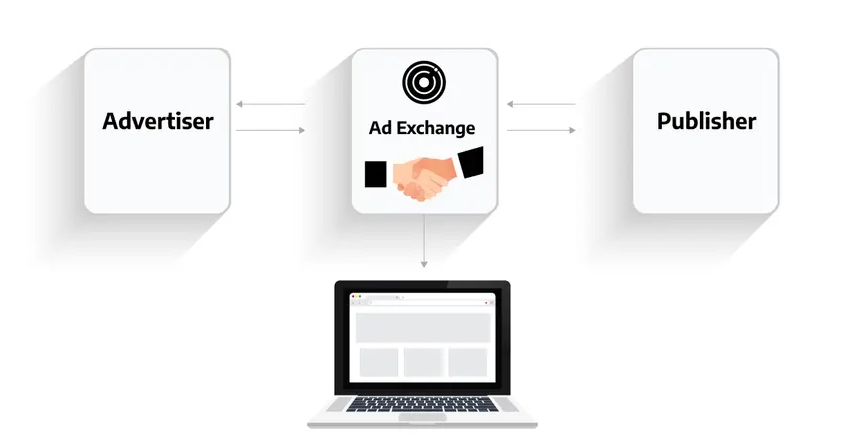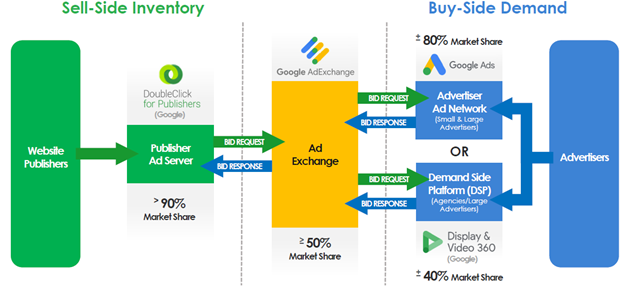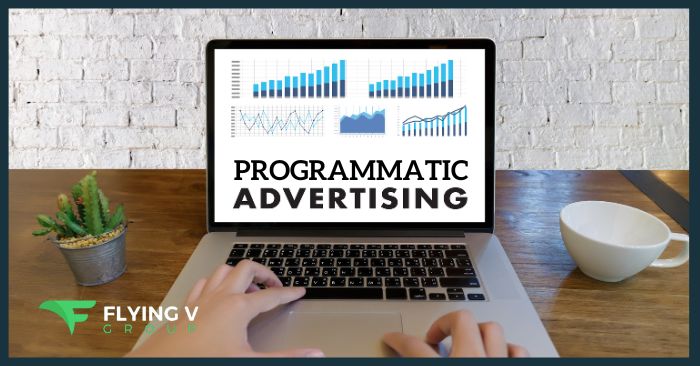Are you struggling to navigate the complex world of ad exchanges as a new entrepreneur? The challenges of selecting the right digital advertising strategy and platform can be overwhelming.
Understanding ad exchange demystifies these complexities, guiding you through the intricacies of programmatic advertising.
This guide breaks down how ad exchanges operate as digital marketplaces, teaches you about various ad types, and simplifies the bidding process for ad space.
With this knowledge, you’ll effectively target your desired audience, ensuring your products reach them precisely when it matters most.
- What is Ad Exchange in Digital Advertising?
- How do Ad Exchanges Work?
- Types of Ad Exchanges
- Benefits of Ad Exchanges for Advertisers
- Don’t Miss Out on Ad Exchange Success with Flying V Group
- FAQs
- What is an example of an ad exchange network?
- Who is the owner of ads exchange?
- Is Facebook an ad exchange?
- What is the difference between an ad exchange and an ad network?
- Can I earn money from ad exchange?
What is Ad Exchange in Digital Advertising?
Have you ever wondered how ads find their way to specific websites or apps? The answer lies in ad exchanges, online marketplaces where advertisers buy digital ad inventory from publishers. This process often occurs through real-time bidding (RTB) auctions, a method where ad space—be it on a website, mobile app, or during a podcast or video stream—is sold in a fast-paced, automated auction.
Publishers: The Sellers of Ad Space
Publishers, the sellers in this scenario, include:
- Website owners
- App developers
- Social media platforms
- Video streaming services
Advertisers: The Buyers of Ad Space
On the flip side, those looking to purchase ad spaces, known as advertisers, comprise:
- Product manufacturers
- Service providers
- Third-party ad agencies
- Intermediary ad networks
- Performance marketers
Advertisers utilize these spaces to display various types of digital ads, aiming to reach specific target audiences.

How do Ad Exchanges Work?
Ad exchanges are like digital marketplaces, but instead of buying and selling products, they deal in ad spaces. Let’s break down how they work using a simple example:
1. Meet the Players:
Imagine a website owner, Emily, who runs a popular blog about gardening. She has space on her blog for advertisements but doesn’t want the hassle of finding advertisers herself. On the other side, there’s a small gardening tool company, GreenTools, looking to advertise its products to gardening enthusiasts.
2. Entering the Ad Exchange:
Emily and GreenTools sign up on an ad exchange platform. Emily lists her ad space, specifying where on her blog the ads can appear. GreenTools, eager to advertise, also joins the ad exchange, looking for websites like Emily’s to place their ads.
3. Setting the Scene:
When a visitor comes to Emily’s blog, a signal is sent to the ad exchange saying an ad space is available. This is where the real-time bidding (RTB) comes in.
4. The Bidding War:
As soon as the ad space is available, advertisers like GreenTools get a notification. They know it’s a valuable space because Emily’s blog is popular among gardeners. GreenTools and other advertisers start bidding for the space. This happens in milliseconds, thanks to advanced algorithms and software.
5. Winning the Bid:
Let’s say GreenTools bids the highest. Their ad for the latest gardening shears instantly appears on Emily’s blog. The visitor, a gardening enthusiast, sees the ad and clicks on it, taking them to GreenTools’ website.
6. Transaction Completed:
Emily earns money for hosting the ad, and GreenTools gets a potential customer. The ad exchange takes a small fee for facilitating this transaction.
7. The Cycle Continues:
This process repeats every time a new visitor comes to Emily’s blog, ensuring both the publisher (Emily) and the advertiser (GreenTools) benefit from the arrangement.
Ad exchanges automate the buying and selling of ad space, connecting advertisers to the right publishers in real-time. This process helps small businesses like GreenTools find the perfect audience efficiently, while website owners like Emily monetize their sites without the legwork of finding advertisers themselves.

Types of Ad Exchanges
Ad exchanges play a crucial role. They come in different types, each catering to specific needs and functionalities. Here’s a breakdown of the main types of ad exchanges to help you understand which might be best suited for your business:
1. Open Ad Exchanges:
These are the most common type of ad exchanges, accessible to a wide range of advertisers and publishers. Open ad exchanges operate like a digital marketplace where any advertiser can bid for ad spaces on a variety of websites. They offer a vast inventory, but because of the open nature, advertisers have less control over where their ads appear.
Example: An e-commerce brand can use an open ad exchange to place ads across multiple websites, reaching a broad audience.
2. Private Ad Exchanges:
Private ad exchanges offer more controlled environments. They are typically invite-only platforms where high-quality publishers offer their ad inventory to a select group of advertisers. This exclusivity means advertisers can target more specific audiences and have greater assurance about the quality of ad placements.
Example: A luxury car brand might choose a private ad exchange to advertise on high-end automotive blogs and websites.
3. Preferred Deals:
These are not standalone exchanges but a feature within them. Preferred deals allow publishers to offer ad inventory to specific advertisers before making them available on the open market. This direct negotiation sets a fixed price, bypassing the typical bidding process.
Example: A health supplement company might negotiate a preferred deal with a fitness blogger for consistent ad placement on their site.
4. Programmatic Direct:
Also known as automated guaranteed or programmatic premium, this type of ad exchange involves direct agreements between advertisers and publishers, with fixed pricing and guaranteed ad impressions. It combines programmatic technology’s efficiency with traditional direct sales’s certainty.
Example: A children’s book publisher may use programmatic direct to place ads on educational websites for parents and teachers.
Benefits of Ad Exchanges for Advertisers
Ad exchanges offer distinct advantages for both publishers and advertisers. By understanding these benefits, both parties can make the most of their digital advertising and monetization strategies.
- Targeted Reach: Advertisers can use data-driven targeting to reach specific audiences, ensuring their ads are seen by consumers most likely to be interested in their products or services.
- Cost-Effectiveness: Real-time bidding in ad exchanges allows advertisers to bid on ad spaces based on their value, helping to optimize ad spend and ROI.
- Diverse Inventory Access: Advertisers have access to a wide range of publishers’ inventory, giving them the flexibility to test different websites and audience segments to find what works best for their campaigns.
- Enhanced Campaign Insights: The analytics provided by ad exchanges enable advertisers to track campaign performance in real-time, make data-driven decisions, and adjust strategies for better outcomes.
- Transparency: Both publishers and advertisers benefit from the transparent nature of ad exchanges, where information about prices, impressions, and audience is openly available.
- Automation and Efficiency: The automation of buying and selling ad space reduces the need for manual negotiations and processes, leading to increased efficiency and reduced operational costs.
- Market Dynamics Understanding: Participation in ad exchanges provides both publishers and advertisers with insights into market trends, pricing dynamics, and evolving consumer behaviors.
By leveraging the benefits of ad exchanges advertisers can execute highly targeted, efficient, and insightful ad campaigns.
Don’t Miss Out on Ad Exchange Success with Flying V Group
In the fast-paced world of ad exchanges, staying ahead is key. Flying V Group offers an exclusive opportunity to leverage its cutting-edge expertise in programmatic advertising. By partnering with us, you avoid missing out on the most effective strategies and technologies. Embrace the chance to work with Flying V Group and ensure your digital advertising efforts are ahead of the curve.
FAQs
What is an example of an ad exchange network?
An example of an ad exchange network is Google AdX (formerly known as DoubleClick Ad Exchange). It’s a highly popular platform that connects advertisers and publishers for buying and selling ad space, often in real-time.
Who is the owner of ads exchange?
Ad exchanges are typically owned by major digital advertising companies. For example, Google AdX is owned by Google.
Is Facebook an ad exchange?
No, Facebook is not an ad exchange. It operates its own advertising platform, Facebook Ads, which allows advertisers to target users on Facebook, Instagram, and its Audience Network, but it does not function as a traditional ad exchange.
What is the difference between an ad exchange and an ad network?
An ad exchange is a digital marketplace for buying and selling ad spaces programmatically, while an ad network aggregates ad spaces from publishers and sells them to advertisers, often not in real-time.
Can I earn money from ad exchange?
Yes, as a publisher, you can earn money from an ad exchange by offering your website’s ad space to advertisers. The revenue depends on factors like your site’s traffic and the attractiveness of your ad spaces to advertisers.






0 Comments